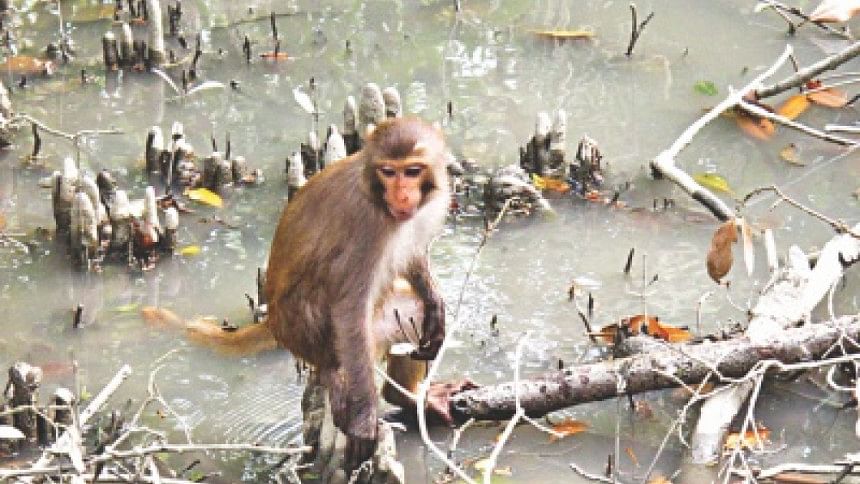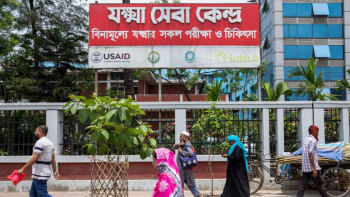YES to Sundarbans NO to projects of environmental destruction

If we say yes to the Sundarbans, then we must say no to the commercial projects harmful for its survival. Whether it is a power plant or any other commercial activity, whether it is foreign investment (FDI) or local investment, whether it is investment from India, or China or the US or any other country, even from Bangladesh, whether it increases the GDP or generates power – this position cannot be compromised. Because there are many alternatives to power generation and commercial activities, but there is not any alternative for the Sundarbans. There are many ways to increase the GDP but there is no way to reproduce the Sundarbans.
This hard truth keeps people alive in resistance against killing of our natural protector, our lungs, and the last of our forests. This year we have entered into the seventh year of our protests against the disastrous projects in the Sundarbans. Along with the National Committee, thousands of people at home and abroad have spontaneously engaged themselves in organising protests that have intensified in recent months. Regrettably, the 1320 MW Rampal coal fired power plant project has become a centre of attraction for other harmful business in and around the Sundarbans. Therefore, it is urgent to scrap the project before it is too late.
The Sundarbans and the project
The Sundarbans, extraordinarily rich in biodiversity, the largest single tract mangrove forest, and a UNESCO natural world heritage site, is intersected by a network of tidal canals, creeks and rivers. More than 4 million people depend on the Sundarbans for their livelihoods. This has also been a huge natural safeguard against frequent cyclone, storm and other natural disasters in the country. Lives and properties of nearly 50 million people will be threatened if there is no Sundarbans. Therefore the Rampal coal fired power plant will actually bring disaster for millions of humans and other non-human lives.
From the very beginning, the project has been suffering from serious shortcomings. The government had selected a natural wetland and fertile agricultural land for the project. Land acquisition order for this power plant was issued on December 27, 2010 – more than two years before the Environment Impact Assessment (EIA) was done. Before the EIA was approved, the joint venture agreement to set up the power plant was signed between the Indian company NTPC and Bangladesh Power Development Board (PDB) on January 29, 2012. A public consultation was arranged by PDB on April 12, 2013. The experts, invited for the consultation, identified serious problems with the EIA; they rejected the EIA and asked the government to stop all activities before another independent EIA was conducted. However, a week later the final agreement was signed by defying that rejection.
In the meantime, more than 3500 landowning families submitted complaints about unlawful acquisition of their land: the police and local thugs were involved in forceful eviction. Many of them did not get the promised compensation. Nearly 8 thousand families are going to be displaced in the process; most affected have been the poor people and the minority communities. A recent investigative report reveals that around two-thirds of the land acquired by the government from the locals has been handed over to local leaders and highly linked people. One such leader proudly claimed that they played a key role when the land was acquired for the plant, also stopped the groups of "bandits" who staged movements and long march against the power plant! (Dhaka Tribune, January 31, 2017)
Major risks
Independent experts from home and abroad have pointed out many aspects of the threats to the Sundarbans. UNESCO, South Asians for Human Rights, Institute for Energy Economics and Financial Analysis, among others, have made independent studies and reached the same conclusion: the project will be disastrous for the Sundarbans.
The rising temperature will also affect the "entire ecosystem and biodiversity of the forest, the marine ecology and the biodiversity of the Passur would be destroyed, as well as the hydrological characteristics of the river including its salinity front, salinity level, sedimentation pattern, and tidal behaviour".
Although the Indian EIA guideline 2010 disallows setting up of similar projects within 25 km of ecologically sensitive areas including forests, rivers, and sanctuaries, the site of Rampal coal fired power plant is located on the north of the Sundarbans, only 14 km away from its boundary.This site is only 2 metres above the sea level; it falls within a tidal delta region which has experienced surge as high as height of 5 meters and witnessed 16 cyclones in the past 25 years.
The plant will annually consume 4.72 million tonnes of coal that will be transported to the project site through the waterways of the Sundarbans (nearly 13 thousand tonnes per day) with serious risk of "coal spillage, ballast water, bilge water, oil spillage, lubricant, and garbage". The current transportation system in the Sundarbans area itself is creating severe sound and water pollution around the forest ecology. The latest accident took place in January when a vessel sunk with 1000 tonnes of coal. This is the latest of series of disasters. The inadequate response of the government to these accidents increases the risks of coal transportation.
To run the power plant, water of the Passur River will be withdrawn (at the rate of 9,150 cubic m/hour) and discharged (at the rate of 5,150 cubic m/hour) into it again after use with a varying temperature. Experts warn that this will reduce the oxygen of the water and damage the fish stocks of the Passur. The rising temperature will also affect the "entire ecosystem and biodiversity of the forest, the marine ecology and the biodiversity of the Passur would be destroyed, as well as the hydrological characteristics of the river including its salinity front, salinity level, sedimentation pattern, and tidal behaviour". Discharged water will also contain a large amount of toxic mercury that will be released from the plant every year. This mercury will be mixed up with the food chain through water system.
Zoologists have shown concern that the toxic substances emitted from the coal-fired power plant including arsenic, lead, mercury, nickel, vanadium, beryllium, barium, cadmium, chromium, selenium, and radium are capable of contaminating the air and water to such an extent that it would affect the reproductive health system of the wild life animals and the species of the Sundarbans. Scientists are concerned that the coal-fired pollution will hamper the existence of rare species of birds in the forest.

Experts have also asserted that so-called "most modern" technology described in EIA is only capable of reducing pollution only 8 to 10 percent. Even if other pollutant reducing technologies are used, no record suggests that risk of pollution could be entirely eliminated. For instance, "the installation of FGD may reduce the risk of SO2 pollution, while increasing the chances of water pollution through the release of heavy chemical materials including Arsenic, Mercury, Selenium and Boron." (Cleansing the Air at the Expense of Waterways, The New York Times, Oct 12, 2009)
A study on the project by the Institute for Energy Economics and Financial Analysis also found that the proposed Rampal power plant is "fraught with unacceptable risk, out of step with the times, and would set Bangladesh back".
Response from UNESCO
After sending several notes of concern, the UNESCO World Heritage Centre and International Union for the Conservation of Nature (IUCN) conducted "a reactive monitoring mission to assess the conservation of this iconic area" in March 2016. It was stated that "The mission was tasked with reviewing potential impacts from the construction of the Rampal power plant, assessing risks from climate change, and evaluating the overall management system of the Sundarbans, including provisions around shipping safety." The mission visited the site of the proposed Rampal plant, as well as the locations of a 2015 cargo vessel accident and 2016 oil spill. It included "meetings with key ministries, industry representatives, port authorities, a small number of researchers and local community members". They were not, however, allowed to meet the pro-Sundarbans experts, organisations and community members.
On October 18, 2016, the World Heritage Centre and IUCN released the final report of the mission. The report concludes that the proposed Rampal power plant poses a serious threat to the heritage site. They summarised their four key concerns as: (1) pollution from coal ash by air; (2) pollution from wastewater and waste ash; (3) increased shipping and dredging; and (4) the cumulative impact of industrial and related development infrastructure. The mission recommended, in clear terms, that the Rampal power plant project be cancelled and relocated to a more suitable location.

NTPC projects could not pass in India and Sri Lanka
Sri Lanka had a similar project with NTPC to build a power plant in Trincomalee in its eastern province. That was finally scrapped on November 1, 2016 because the government took public concern and experts' opinion seriously. Sri Lanka decided to look at options such as Liquefied Natural Gas (LNG), solar and wind power. (Sri Lanka scraps NTPC's plan to build coal plant, The Hindu, Sept 13, 2016)
In recent years, number of coal power projects, mostly by NTPC, were cancelled or halted in India due to environmental concern. Most recently (July 4, 2016) the Union environment ministry's expert panel deferred giving green clearance to NTPC Ltd's 2,660 megawatt (MW) super thermal power plant in Madhya Pradesh to preserve the Khajuraho temple and nearby tiger and crocodile sanctuaries, which are about 20-30km from the power plant site. (Panel defers green clearance for NTPC's Rs18, 000 crore plant in Madhya Pradesh, Live Mint, July 4, 2016)
It should also be noted here that Indian Centre for Science and Environment (CSE) conducted a study to assess performance of NTPC and found it as "below par". They revealed that "the NTPC did not disclose its data, and hence was rated based on a primary survey and publicly available information. The six plants of NTPC that were rated received scores of 16-28 percent. (India's first-ever environmental rating of coal-based power plants finds the sector's performance to be way below global benchmarks, Centre for Science and Environment, Feb 21, 2015)
The protests and the government
So far we have tried our best to convince our government that the largest mangrove forest should not be a playground for grabbers, mindless business, it must survive for our survival. There have been many research studies, discussions, debates, publications and also exchanges with the government bodies as well as demonstrations, protest meetings and long marches to Sundarbans to make the point. There were also cycle rallies, art exhibitions on the Sundarbans were organised, many songs and documentaries were created by spontaneous initiatives from young people. Moreover, we wrote open letters to both the prime ministers of Bangladesh and India. But the government has shown extreme insensitivity towards all public exhortations.
But despite that, people have not given up. Support for the movement have spread fast to all sections of the society. On November 26 last year, "cholo cholo Dhaka cholo" (March to Dhaka) culminated into a grand gathering of more than 20 thousand people at central Shaheed Minar. In the last few months there were also public polls in different places including public universities. Nearly 41 thousand students and teachers cast their vote in these unofficial but transparent referendums. More than 92 percent cast their vote against Rampal coal fired power plant to save Sundarbans.
Global protests
About 200 organisations from different countries appealed to scrap the project last year. On January 7 "global protest day for Sundarbans" was celebrated in many cities around the world.
A large number of experts and activists in India expressed their solidarity with the movement in many ways including participation in long march. A number of protest rallies and solidarity meetings took place in Kolkata and Delhi. To register solidarity with Bangladeshi protestors, Indian scientists, environmentalists, teachers, film makers, writers, researchers, fish workers, forest workers urged their prime minister through a press conference in Delhi to withdraw the project. They argued that, "This project is opposed by people in Bangladesh and India for its monumental social and environmental negative impacts, particularly the irreversible damage to Sundarbans and the fragile ecosystem around it. The project is partly owned by NTPC, financed by Indian Exim Bank, equipment's supplied by BHEL and Price water house Coopers Private Limited, India contracted for long term coal sourcing. Hence India's share in this project is significant." (Protest in India over Rampal power plant, The Daily Star/ANN, Oct 19, 2016)
Matter of common sense and sensitivity
For any sensible person it is a matter of common sense that no project can be called a development project if that is a threat to the survival of the Sundarbans. There is sufficient scientific evidence, arguments, and facts and figures to support this. But the problem arises when authorities are not prepared to accept the scientific evidence.
Real development should aim at GDP growth without long term irreversible destruction of nature and threat to human survival. We would like to stress on the point that no lethal experiment should be taken where the Sundarbans is concerned. Therefore, we call for the cancellation of the project immediately and to stop other harmful navigation and commercial activities in and around the Sundarbans. If Sri Lanka and India could scrap similar projects, why not Bangladesh, to prevent a much bigger disaster?
The writer is Professor of Economics, Jahangirnagar University. Email: [email protected]

 For all latest news, follow The Daily Star's Google News channel.
For all latest news, follow The Daily Star's Google News channel. 



Comments